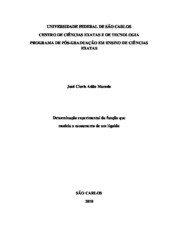Determinação experimental da função que modela o escoamento de um líquido
Abstract
In our nearly 40 years of teaching we have observed that many students have mathematics as a great number of rules and formulas that need to be memorized. They do not see any meaning in what they learn either. Few realize the applications of mathematics although they know that they really exist. In an attempt to teach mathematics in a more significant way we decided to conduct an experiment to find out what mathematical knowledge it "hides". The flow of a liquid was the chosen experiment. Analyzing it from a modeling point of view, we intend to find out if there is a mathematical model which can describe it. The functions were obtained from an analysis of initially discrete data and then making the transition to the continuous. Students had the opportunity to construct and interpret graphs associated with related functions, quadratic and polynomial of degree greater than two using Excel. We work with students of the three high school series in a public school. Each class was divided into groups of three or four members. We used the Didactical Engineering as a research methodology.
